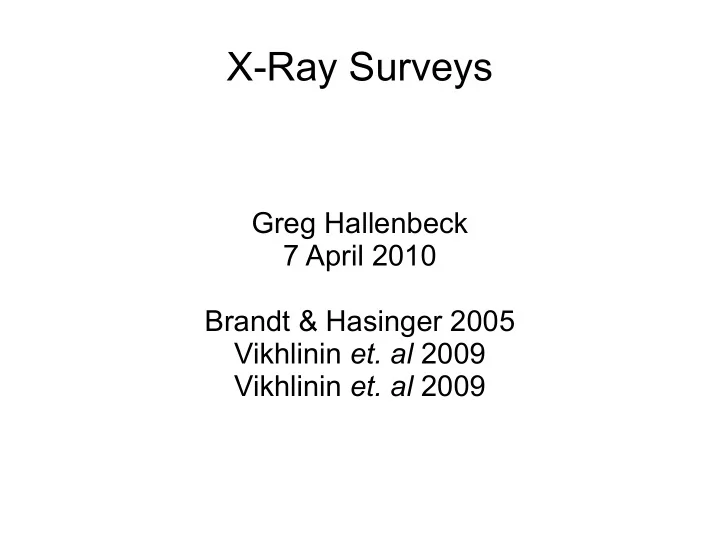

X-Ray Surveys Greg Hallenbeck 7 April 2010 Brandt & Hasinger 2005 Vikhlinin et. al 2009 Vikhlinin et. al 2009
Overview ● Previous Surveys using Chandra and XMM-Newton ● How are they different? ● What have they found? ● What science does this enable? ● Future Surveys with WFXT and IXO ● How are they different? ● What science will be made possible?
Past and Current Surveys Blue: Chandra Green: XMM-Newton Purple: Earlier Both telescopes have significantly pushed down flux limits, but their surveys cover very small areas as a consequence of long exposure times
Satellite Data ● Chandra ● Position Accuracy < 1” ● Background ~1 count / 2 months / pixel (0.5-8 keV) ● Almost no source confusion ● X-Ray Multi-Mirror Misson-Newton (XMM-Newton) ● Position Accuracy 1-3” ● Wider Field of View (2.5x Chandra's) ● Larger Collection Area ● Tends to cover larger solid angle
Source Counts and Classification ● Each survey has about 100-600 detections over areas of 0.1-10 square degrees ● Many sources very faint optically ● Get poor or nonexistent optical spectra ● So, low completeness in: ● Redshift data (50-70%) ● Classification (< 60%)
Source Types ● AGNs ● Unobscured (0 < z < 5) ● Obscured in X-Ray but not optical/UV (z < 1.5) ● Optically Faint X-Ray Sources (1 < z < 4) (Obscured AGNs?) ● X-Ray Bright, Optically Normal Galaxies (XBONGs) (0.05 < z < 1) ● Other Stuff ● Starburst Galaxies (0.1 < z < 1.5) ● Galaxies and Groups (0.1 < z < 1) ● X-Ray Bright Galactic Stars
Sources Found (0.5-2 keV)
Sources Found (2-8 keV)
Cosmic X-Ray Background (CXRB) ● Discovered by Giacconi et. Al 1962 ● Appeared nearly uniform over entire sky ● Later found to be mostly AGNs (~70%), but has only been partially resolved ● Resolution Levels by these surveys: ● Have resolved ~90% of 0.5-2keV CXRB – Previously 75% by ROSAT ● ~85% at 2-6keV ● ~60% at 6-10keV
AGN Evolution / SMBH Growth Schmidt 1968 shows growth in number density of AGNs with z (for low z) But at deeper redshifts... Number density of moderate luminosity AGNs peak near z = 2 before dropping off sharply Can use this luminosity function to estimate SMBH masses
Demographics and Physics of High z AGNs ● The surveys are sensitive enough to detect moderate strength AGNs at high z > 4 ● Huge volume gives statistics on “typical” AGNs ● Optical surveys just see the biggest ● Some Findings: ● Distant AGNs seem to accrete in the same modes as local AGNs ● AGNs did not dominate reionization
Surveys with WFXT: The Wide-Field X-Ray Telescope Goal of Chandra and XMM-Newton sensitivity, but over a large area of the sky (10-25%) With estimated 100 objects per sq. deg, should get tens of thousands of objects FOV of 1 sq. deg 8,000cm² collecting area
Cluster Mass Function Science Cluster mass function is sensitive to ΩΛ and ΩM WFXT would be able to measure cluster masses out to z=2 (when they showed up) But the cluster mass function can also be used to measure the...
Growth Factor of Density Perturbations G(z) ● Indicates how small primordial fluctuations increase with time ● G(z) increases as z decreases ● Note that the y axis is multiplied by (1+z) ● WFXT provides independent measure for z < 1 (shown in blue) ● Non-GR theories tend to predict fairly different values ● DGP Model (dashed) ● Quintessence (solid)
Other Science with WFXT ● Find statistics of many unusual objects like the “Bullet Cluster” with greatly increased search volume ● Used to find departures from ΛCDM ● More detailed measurement of mass-dependent power spectrum of groups and clusters ● Measure cluster-cluster correlation function on non-linear scales, and over wide range of spatial scales
Surveys with IXO: The International X-Ray Observatory ● WFXT should find a lot of objects, but not collect much information on each object ● IXO has both greater: ● Collecting Area ● Spectroscopic Resolution ● Even for high z > 2 objects, still high precision on ● Temperature ● Metallicity ● Velocity Structure
Science Made Possible with IXO ● Measure gas fraction in large, dynamically relaxed clusters ● Use f gas ~ d 3 / 2 trend to get d(z) and constrain Ω Λ , and Ω m ● Extend G(z) to z > 2 ● Possibly as good as JDEM ● Measure “growth index” γ ● Non-GR theories give fairly unique values
Fin (The pun seemed funny at 3am while I was observing)
Recommend
More recommend